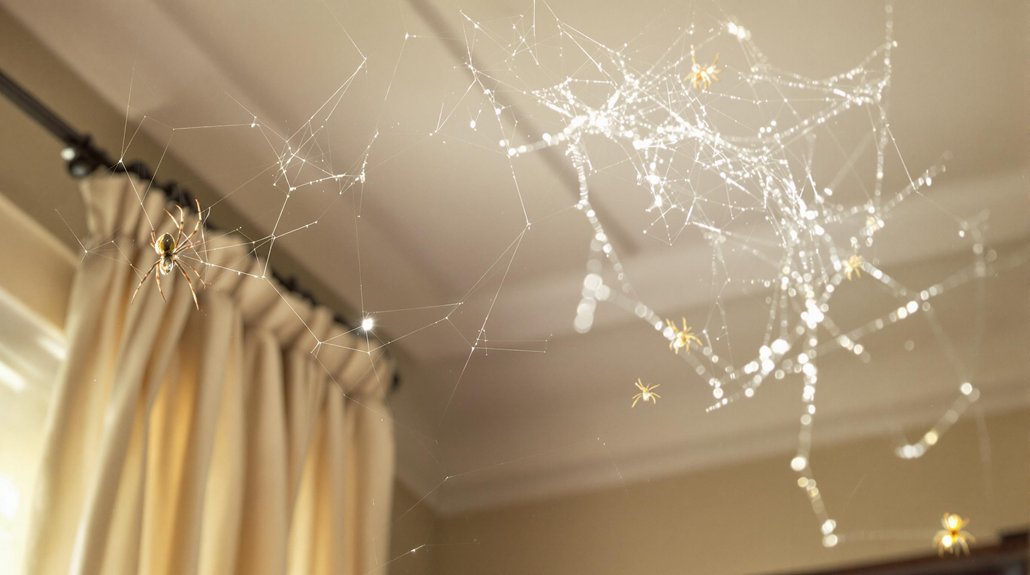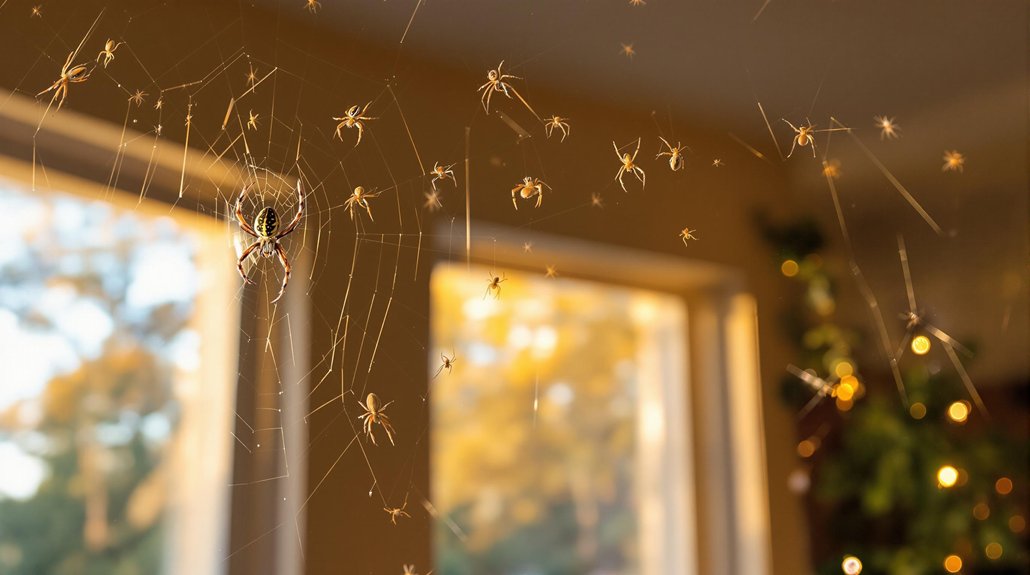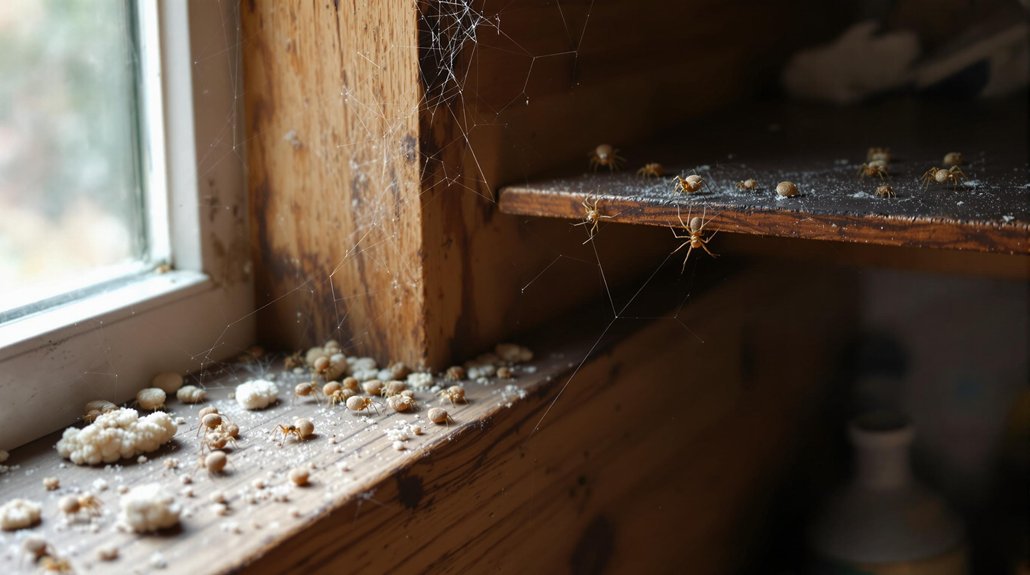Seeing a few spiders in a house in Clayton North Carolina is normal and usually not a reason for concern. Most homes encounter small numbers of spiders, especially in quiet, undisturbed areas like corners or basements. They tend to avoid humans and do not indicate an infestation. The number of spiders seen can vary with seasons and environmental conditions. To learn more about managing common spider activity, continue exploring this useful information.
Key Article Highlights
- Seeing a few spiders occasionally, especially in corners or basements, is typical and not a sign of infestation.
- Most indoor sightings are harmless, passive species like house and cellar spiders.
- Frequent or multiple sightings in high-traffic areas may indicate a larger issue needing attention.
- Environmental factors, such as humidity and outdoor surroundings, influence the number of spiders indoors.
- Regular cleaning, sealing cracks, and outdoor maintenance help keep spider sightings within normal limits.
Typical Spider Activity in Clayton Homes

In Clayton homes, it is common to encounter a small number of spiders throughout the year. Spider behavior is generally cautious; they tend to avoid human activity and are most active during quiet times. The home environment provides suitable places for spiders to hide and build webs, such as corners, basements, and storage areas. These areas offer shelter and access to insects, which are their primary food source. Spiders do not seek to invade homes intentionally but may enter seeking shelter or food. Their presence is usually minimal and not a sign of infestation. Understanding this typical activity helps homeowners recognize normal spider behavior and appreciate their role in controlling other pest populations within the home environment.
Factors That Influence Spider Presence
Several factors can influence the presence of spiders in a home. Spider behavior affects how often they enter and stay inside, as some species are more likely to seek shelter indoors. Habitat preferences also play a role; spiders prefer dark, undisturbed areas such as basements, closets, and corners. Environmental conditions like humidity, temperature, and clutter can attract spiders or encourage their movement indoors. A home with many insects may also increase spider activity, as they hunt for food. Additionally, outdoor surroundings such as gardens, woodpiles, and tall grass provide nearby habitat, increasing the chance of spiders migrating inside. Understanding these factors helps homeowners manage spider presence effectively by reducing suitable habitats and limiting entry points.
Common Spider Species Found Indoors
Common spider species found indoors include the American house spider, the cellar spider, and the cobweb spider. These are among the most common indoor spiders in homes. American house spiders often build irregular webs in corners, showing a preference for quiet, undisturbed areas. Cellar spiders tend to create messy, tangled webs in basements or dark corners, exhibiting slow, deliberate movements. Cobweb spiders are known for their distinctive, dense webs found in corners or ceilings. Understanding their behavior patterns helps homeowners recognize normal spider activity. Most common indoor spiders are harmless and tend to be passive, avoiding contact. Their presence typically indicates they are seeking shelter or food sources inside. Recognizing these species and their behaviors provides clarity on what constitutes normal spider sightings in a home.
Signs of Infestation vs. Normal Sightings

Frequent sightings of spiders can indicate an infestation, especially if they appear daily. Unusual web locations, such as in high-traffic areas or unusual spots, may also signal a problem. Recognizing these signs helps determine if the spider presence is normal or needs attention.
Frequent Spider Sightings
People may notice spiders in their homes from time to time, which is usually normal. Spiders often exhibit specific spider behavior that keeps them in indoor habitats where they find food and shelter. Frequent sightings of spiders can indicate a higher presence or potential infestation, especially if they appear in multiple rooms or at different times. However, occasional appearances are part of natural spider activity, as they seek out food sources like insects. Understanding the difference between normal spider behavior and signs of an infestation is important. If spiders are seen repeatedly despite cleaning and reducing clutter, it may signal a larger issue. Generally, normal sightings involve isolated instances, while frequent sightings suggest a need for closer inspection or pest control.
Unusual Web Locations
Unusual web locations can be an important sign of a spider infestation. While most spiders build webs in common areas like corners or behind furniture, unusual web types and web building locations may indicate a problem. For example, webs found in high-traffic areas or on ceilings are less typical. Spiders often create webs in dark, undisturbed spots, but if webs appear in open spaces or near food sources, it could signal an infestation. Additionally, irregular web shapes or large, messy webs may suggest an increased spider presence. Recognizing these signs helps distinguish between normal sightings and a potential problem. Monitoring web building locations and types can provide an early warning, allowing homeowners to take action before the spider population grows.
Seasonal Changes in Spider Sightings

Seasonal changes greatly affect the number of spiders found inside homes. During warmer months, spider activity increases due to seasonal variations and climate impact, leading to more sightings indoors. As temperatures drop in fall and winter, spider presence generally decreases as they seek shelter outside. The table below summarizes how seasons influence spider activity:
| Season | Typical Spider Activity |
|---|---|
| Spring | Increased web-building and sightings |
| Summer | Peak activity, more indoor sightings |
| Fall | Reduced sightings as spiders prepare for winter |
| Winter | Minimal activity, few spiders indoors |
| Shift | Fluctuations depending on weather patterns |
Understanding these patterns helps homeowners anticipate spider presence and manage expectations throughout the year.
When to Consider Pest Control Assistance
Pest control assistance should be considered when spider activity becomes persistent or problematic inside the home. Recognizing signs of infestation, such as frequent sightings, cobwebs in corners, or finding multiple spiders in one area, indicates it may be time to explore pest control options. If spiders are invading living spaces or hiding in cluttered areas, professional intervention can help manage the situation effectively. Pest control services offer targeted treatments that reduce spider populations and prevent future issues. It’s important to address these signs early to avoid an escalation of the problem. When spider activity remains constant despite cleaning efforts, consulting a pest control expert guarantees a thorough approach to maintaining a spider-free environment.
Tips for Managing Spiders Around Your Home
To effectively manage spiders around a home, it is important to take simple preventative steps. Regular cleaning and decluttering reduce hiding spots and make the environment less attractive to spiders. Sealing cracks and gaps in windows, doors, and walls prevents entry. Using preventive measures such as weather stripping and door sweeps creates a barrier against pests. Natural repellents, like peppermint oil or citrus peels, can help deter spiders without chemicals. Applying these repellents around entry points and dark corners can reduce spider presence. Keeping outdoor areas tidy and removing debris also limits spider habitats. Consistent maintenance and natural deterrents are effective strategies for managing spiders and maintaining a pest-free home environment. These proactive steps promote safety and comfort for residents.





